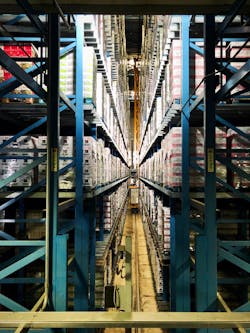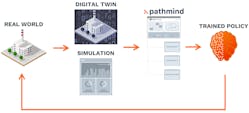After March’s Suez Canal blockage and last year’s bout of empty store shelves during the fallout from the COVID-19 pandemic, the integrity of supply chains is on everyone’s mind. Yet even before these recent debacles, similar disruptions had begun to creep into view. In many ways, current trends merely represent the result of long-gestating issues.
“I believe it’s nothing short of historic the amount of pressure that we’re dealing with. It’s everything from soaring freight rates, capacity shortages in containers, driver shortages, imbalanced carrier networks, warehouse labor and space being in short supply, and then natural disasters like COVID-19 or even environmental events,” said Jonathan Foster, principal consultant at Proxima, a procurement consultancy group. “2020 was the year of disruption. It’s coming from everywhere, and the amount of pressure we’re seeing is unprecedented.”
To get a better understanding of how these issues are impacting the Automation World audience, we conducted a survey to shed light on how industrial companies are using supply chain automation technologies to adapt to these constraints.
According to the survey, only 44% of respondents are currently using some form of supply chain software. When asked “If your facility does not use supply chain software, is your company planning to add it?” 15% responded “Yes, in the next year,” 46% responded “In the next few years,” and the remaining 39% indicated that it was not in their near-term plan at all.
While supply chain software suppliers expressed some surprise that, in such a globalized business landscape, more than half of respondents still have not adopted advanced supply chain software products, they ultimately conceded that it is in line with their experience working with clients.
To have 56% not using supply chain software “does seem like a big number,” says Shaun Phillips, director of product management at QAD DynaSys (QAD’s supply chain software). “But frankly, if I did a survey of our entire installed base and asked them which system our solution replaced, I would expect that close to 60% of them would say Microsoft Excel. Even among the customers we’ve sold to in the last month, a large portion of them are still at that stage.”
The reason for this is that supply chain automation largely subsists on the collection of data from Industrial Internet of Things (IIoT)-enabled sensors and devices. As such, companies that are still lagging in their overall digital transformation may not possess the infrastructure necessary to fully leverage a more sophisticated supply chain software product. Beyond that, while supply chain software that can automate data collection and communication or allow end-users to engage in more precise demand-planning may allow them to optimize their production workflow, older software systems can still satisfy their fundamental needs when push comes to shove.
Still, some industry sectors have been faster to evolve than others. According to Phillips, manufacturers of consumer electronics have been strong adopters of supply chain software because their notoriously slim profit margins require them to cut costs any way they can. By better matching supply to demand, they can maximize the amount of product moved while limiting excess stock. As a result, they can improve their time-to-market for shorter, more varied product runs.
In addition, highly regulated fields, such as food and beverage and pharmaceutical production, have been among QAD’s most prominent clients, Phillips says. For these companies, while reducing costs and improving lead times remain important goals, their primary emphasis in revamping their supply chain systems is increasing quality and traceability. In these cases, better software can assist in automating the collection and communication of plant-floor data to the various participants in a given supply chain, allowing them to ensure that products which may have a finite shelf-life reach their intended destination on time while also meeting stringent quality requirements.
Integration trends
To better understand why some companies are shifting toward more sophisticated supply chain planning, it’s important to understand the two often-contradictory goals they are tasked with achieving. On the one hand, shrinking margins require them to run their operations more efficiently. This means that they must limit costs, which often entails adopting just-in-time models to minimize freight and inventory expenses. However, increasingly prevalent disruptions—whether they be natural disasters or geopolitical shake-ups that limit trade—render this model challenging, as they require companies to hold more safety stocks to increase their resiliency.
As a result, software that grants users predictive capabilities or allows them to engage in complex, parallel planning for multiple “what-if” scenarios is expected to continue gaining traction in the future, says Chris Nicholson, CEO at Pathmind, a supplier of artificial intelligence (AI) simulation models for supply chain data. These software products, driven by end-to-end data visibility and machine learning algorithms, allow end-users to ensure that they are prepared for a variety of potential scenarios while still limiting their freight and inventory costs as much as possible.
The growing need for end-to-end visibility is particularly relevant for plant-level operators and systems integrators because it often requires more integration between supply chain software and manufacturing execution systems (MES) to extract granular data such as equipment health and material availability that can help to more accurately gauge a facility’s true capacity. Collecting and communicating this data to supply chain partners in real time can assist them in more effectively coordinating their own procurement and inventory activities.
“A normal enterprise resource planning (ERP) solution that is integrated with supply chain capabilities might take in orders and then create requisitions or releases for customers. Then, maybe they could also schedule things on the shop floor taking into consider things like material availability,” says Andrew Robling, senior product manager at Epicor, an ERP, MES, and supply chain software provider. “When it comes to getting data off the floor—as far as what was actually produced—that tends to be more of an MES task. The MES has integration to machines, so it can automate that collection of data.”
This uptick in MES integration was borne out in our survey, which found that 68% of respondents had connected their supply chain software to their MES in some way. Moreover, while 61% of respondents indicated that this integration was via ERP, the remainder specified that the integration was directly to their MES.
Evolving capabilities
Going forward, supply chain planners may not only be reaching for more data inside plants, but outside of them as well. According to Phillips, increasingly inventive uses of big data to engage in more precise demand planning will continue to become more commonplace. As an example, he notes the case of a company that manufacturers a consumer good requiring the import of raw materials. This company found that by purchasing public domain customs data on the quantity of their primary material inputs being brought into the U.S., they were able to make deductions about the activity of competitors in their geographic region. Similar cases also abound in industries that produce building materials, where information from banks pertaining to the issuance of mortgage loans can be used to predict demand based on new construction starts.
Because this type of demand forecasting relies on large quantities of rapidly changing data from disparate sources, it’s likely that supply chain software products offering it will be cloud-based. Moreover, having more data in the cloud is likely to fuel synergistic growth with another trend sweeping over the supply chain software market: machine learning.
According to Nicholson, machine learning allows companies to make use of data in a way human analysts simply can’t. For instance, one company using Pathmind’s software was able to take order data for multiple products coming from its ERP and group them together based on material commonalities. After doing this, orders on similar batches of products could be grouped and routed through CNC machines together to minimize deliveries between them and reduce material wastage. The same sort of large-scale coordination could be applied to delivery trucks moving products across a distribution network, Nicholson notes.
“AI offers expansive visibility. It means you can see more than any individual actor or even isolated system could see because it offers real-time visibility across so many different machines and systems,” he says. “It’s like a control tower. Imagine trying to run an airport without a control tower by telling all of the individual planes to land as safely as they can.”
Ultimately, even with trends such as reshoring on the rise, global supply chains will still play a major role in manufacturing. As such, the manufacturing industries will need to be prepared for a world in which complex supply chain planning plays a greater role in their overall operations. According to Phillips, many companies are having what he calls an “Amazon moment.”
“Amazon was the first to come up with the idea of using lead times to better serve market segments. If you order something, you can get it the next day or even later in the afternoon. They made supply chain capability into a market strategy,” he says. “What supply chain software can bring to a company is changing. There was a time when it was seen as a necessary evil that was just a cost center needed to synchronize industry flows, but now it’s becoming a competitive differentiator. Now, you can actually use your supply chain to reduce costs, improve service levels, reduce wastage, and guide where you grow and defend your market.”


